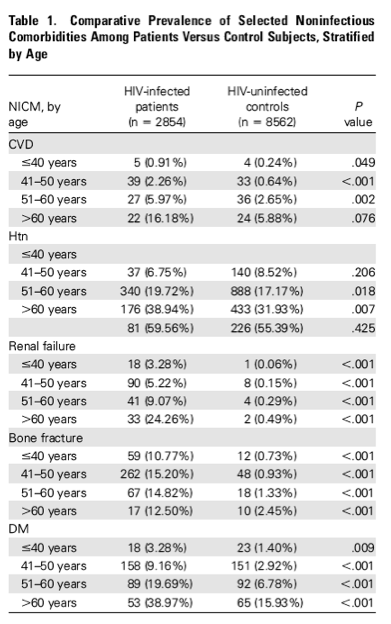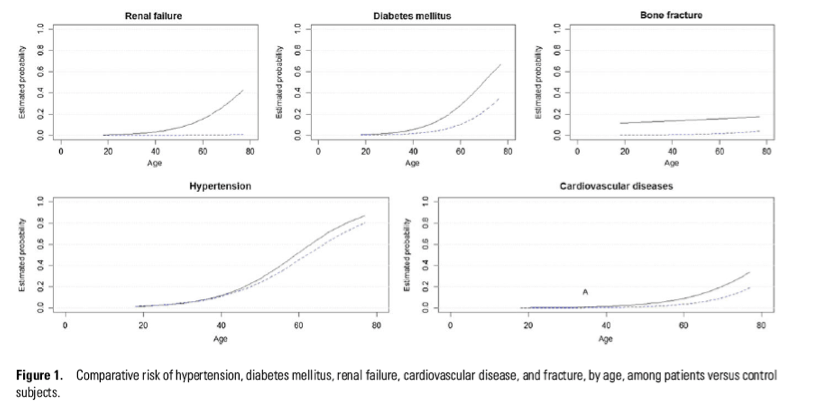| |
4 Aging Published Reports This Week:
|
| |
| |
cumulative HIV viral load exposure increases mortality, in this study this is stunning "an independent 44% increase in mortality risk was observed per 1 unit increase in log10 copy X year/mL of cumulative VL burden". HIV+ have much higher rates of comorbidities compared to HIV-neg in control group in Italian Guaraldi study, are much more likely to have multiple comorbidities and are much more likely to have this happen to them 10-15 years earlier than to HIV-negatives; HIV+ had much rates rates, 5-15 times greater, of renal failure, bone fractures, and diabetes and several times higher rates of heart disease. In the SWISS COHORT HIV-positives had lots of comorbidities. Jaqueline Capeau, a noted French researcher who has focused quite a bit of research on comorbidities & lipodystrophy, reviews this subject.
Reported by Jules Levin, NATAP
(soon >50% of HIV+ will be over 50 & 30% will be >60. we need to better understand the cause although we have some understanding, better prevention, intervene with diagnosis sooner, and find a treatment intervention for patients who are already >50 yrs old. Diet & exercise are as of now the BEST intervention to prevent early onset of comorbidities & inflammation, that means early start of vigorous exercise (250+ minutes a week of vigorous aerobic exercise) and a diet resembling a mediterranean diet: fish, chicken, vegetables, fruit, beans, nuts.
"HIV-infected patients >50 years of age can be considered to be old.....early occurrence of these age-related comorbidities in HIV-infected patients.....At a given age, HIV-infected patients (in Italian Guaraldi study) had a greater likehood of comorbidities than did control (HIV-neg) subjects paired for age, sex, and ethnicity.....A second important point revealed by Guaraldi et al is the simultaneous presence of 2 or more comorbidities (among cardiovascular diseases, hypertension, diabetes, bone fractures, and renal failure) in a given patient, called polypathology. Polypathology occurrence was similar in HIV-infected patients aged 40 years and in control subjects aged 55 years, revealing the 15-year-earlier aging. Why? Is the entire aging process accelerated in these patients? Are all HIV-infected patients aging too rapidly? What can be done?......Immune activation is increased in HIV-infected patients because of residual HIV infection. Markers of bacterial translocation, such as lipopolysaccharide, and of innate immunity activation, such as sCD14, together with indications of elevated immune activation, have been linked to neurocognitive and cardiovascular comorbidities and to mortality. Of importance, levels of sCD14 were related to those of interleukin 6 and C-reactive protein. Increased levels of all these markers were observed in patients with well-controlled HIV infection and associated with increased mortality
Premature Aging and Premature Age-Related Comorbidities in HIV-Infected Patients: Facts and Hypotheses - (10/21/11)
Review by Jacqueline Capeau.....WHAT IS WRONG WITH AGING HIV+ - chronic inflammation is probably related to long-term immune activation in response to the antigenic burden that we encounter throughout life, with increased production of proinflammatory cytokines, at first by activated macrophages and other immune-cell types, leading to immunosenescence......if we consider that increased immune activation and long-term chronic inflammation are major players in the aging process in the general population, it is obvious that these processes are more prevalent in HIV-infected patients, even when the infection is well controlled, than in the general population; HIV-infected patients will be more prone to develop, in advance, age-related diseases......In addition to all the factors related to the virus and the treatment, a number of environmental factors could also prematurely induce aging, such as smoking, sedentary lifestyle, low-nutrition diet and resulting fat gain, or drug use. Even if difficult to do, these factors need to be aggressively taken in charge.
WHAT CAN WE DO? NOT MUCH (from Jules): It is important to diagnose and treat the comorbid conditions. To date, use of immunomodulatory or anti-inflammatory agents, such as statins, aspirin, or hydroxychloroquine, to decrease this inflammatory and/or immune activation burden is not validated but should be considered. In addition, the early treatment of HIV-infected patients may help to delay aging.
Viremia Copy-Years (Cumulative Viral Load Exposure) Predicts Mortality Among Treatment-Naive HIV-Infected Patients Initiating Antiretroviral Therapy - (10/20/11).....
Viremia copy-years, a measure of cumulative plasma HIV RNA exposure and de novo viral replication, demonstrated a strong association with all-cause mortality in a large sample of HIV-infected patients who started ART
Morbidity and Aging in HIV-Infected Persons: The Swiss HIV Cohort Study - (10/21/11).....
Comorbidity and multimorbidity because of non-AIDS diseases, particularly diabetes mellitus, cardiovascular disease, non-AIDS-defining malignancies, and osteoporosis, become more important in care of HIV-infected persons and increase with older age....The leading causes of death were malignancies (40 [23%] of 177), infectious diseases (14.6%), and cardiovascular events (12.4%)......In looking at table 3 in this report you can see significantly increased rates of NonAIDS Comorbidities in 50-64 age group compared to <50: cerebral infarction, coronary agioplasty, other CVD diseases, fractures, osteoporosis, diabetes, liver events, pancreatitis, malignancies, kidney events.....
Other age-related comorbidities were also found [in Italian study] to be more prevalent in adult HIV-infected patients than in the general population: neurocognitive disorders, non-AIDS-defining cancers, sarcopenia, and frailty [1, 2]. It is now frequently considered that HIV-infected patients are aging prematurely, considered to be old when .>50 years of age, compared with 65 years of age in the general population.....In the Swiss HIV Cohort Study [3], the incidence of diabetes, coronary angioplasty, myocardial infarction, osteopororosis, and non-AIDS-related cancers was increased among patients aged >50 years, compared with those aged <50 years, and was not further increased among patients >65 years, suggesting that HIV-infected patients >50 years of age can be considered to be old......Guaraldi et al [5] analyze the important cohort of patients followed up at the Metabolic Clinic of Modena (Italy): they found the early occurrence of these age-related comorbidities in HIV-infected patients.....they were able to compare these patients with persons from the general population who were part of a large Italian observational database, CINECA ARNO, that records health information. At a given age, HIV-infected patients had a greater likehood of comorbidities than did control subjects paired for age, sex, and ethnicity.
Premature Age-Related Comorbidities Among HIV-Infected Persons Compared With the General Population - (10/21/11) Italian Guaraldi study
"emerging description of an HIV-specific aging phenotype"..Additional studies are needed to further evaluate the impact of convergent age-related NICMs on age-related functional status, frailty, and disability among ART-experienced HIV-infected persons and to provide insights into accelerated aging processes that may be associated with chronic HIV infection.
1. In this large case-control study that compared ART-experienced HIV-infected patients with adult control subjects from a population-based Italian national registry, we confirmed that frequently observed age-related NICMs (non-AIDS comorbidities) were significantly more common in HIV-infected patients than in the general population, in corroboration of data from other cohorts
2. the simultaneous presence of >2 NICMs or Pp (multiple comorbidities) was consistently more common in HIV-infected patients than in the general population. These differences were apparent across broad age strata ranging from <40 years to >60 years and tended to decrease with advancing age. The prevalence of Pp among HIV-infected persons was approximately equivalent to prevalence observed in members of the general population who were 10-15 years older
3. The simultaneous presence of CVD, Htn, DM, renal failure, and bone fracture can reasonably be considered to represent a frailty phenotype that has been associated with aging in the general population and is a major determinant of disability associated with geriatric syndromes [29, 30]. We believe that, in this report, by showing the premature onset of Pp among HIV-infected patients, we have contributed to the characterization of an emerging description of an HIV-specific aging phenotype.
4. Factors that could readily account for the occurrence of multiple traditionally age-related NICMs at significantly earlier ages among HIV-infected patients compared with HIV-uninfected persons are not immediately apparent. However, multiple hypotheses have been made to explain the premature aging that is thought to occur among HIV-infected persons, particularly those for whom ART is delayed until more advanced stages of immunodepletion and for whom more long-term chronic exposure to HIV viremia occurs [11, 31]. Pathophysiologic mechanisms that have been proposed include higher levels of chronic systemic inflammation, reduced vascular endothelial reactivity (as assessed by flow-mediated dilation), and increased endovascular hypercoagulability (as assessed by increased platelet aggregation and fibrin deposition)
5. We found that HIV-specific factors (lower nadir CD4 cell count and more prolonged ART exposure) were independent predictors of Pp in multivariable regression models
6. We found that the diagnosis of Htn (hypertension) was strongly and independently associated with an increased likelihood of other NICMs being present (Pp) simultaneously, in both patients and controls, and that Pp in both groups prominently included CVD. Although this association makes clinical and pathophysiologic sense, we nevertheless demonstrated that our observed increases in prevalence of DM, CVD, bone fracture, and renal disease occurred independently in models that adjusted for sex, age, and Htn.
7. In conclusion, our findings suggest that an aggressive approach to the screening, diagnosis, and treatment of NICMs is warranted as part of routine healthcare for HIV-infected patients. Furthermore, our data suggest that onset of such screening should commence at a substantially earlier age for HIV-infected persons, compared with HIV-uninfected persons, possibly at least a decade in advance.
8. Additional studies are needed to further evaluate the impact of convergent age-related NICMs on age-related functional status, frailty, and disability among ART-experienced HIV-infected persons and to provide insights into accelerated aging processes that may be associated with chronic HIV infection.
"a 40-year-old HIV-infected person displayed a Pp (multiple comorbidities) risk similar to that seen in a 55-year-old control subject." Figure 3 shows the risk (probability) of Pp
Factors significantly associated with Pp were age (per 1 year of increase: OR, 1.11; 95% CI, 1.10-1.12; P < .001), male sex (OR, 1.77; 95% CI, 1.44-2.17; P < .001), nadir CD4 cell count <200 cells/μL (OR, 4.46; 95% CI, 3.73-5.34; P < .001), and exposure to ART (per 1 month of exposure: OR, 1.01; 95% CI, 1.001-1.019; P = .001).
Figure 2 depicts the prevalence of Pp in patients versus controls, stratified by age. Across all age strata, Pp prevalence was significantly higher among patients, compared with controls (all P <.001). Pp prevalence among patients aged 41-50 years was 9%, which was not significantly different from the prevalence observed among controls aged 51-60 years (6.6%; P = .282).

The Table 1 shows the comparative prevalence of NICMs between HIV-infected and uninfected patients, stratified by age. Significantly higher prevalences of renal failure, bone fractures, and DM were observed among HIV-infected patients, compared with controls in all age strata. CVD and Htn prevalence were similar among patients and controls for persons >60 years of age.
Figure 1 depicts logistic regression analyses that assessed the comparative risk (OR) for renal failure, DM, bone fracture, Htn, and CVD with use of age as a continuous variable between patients and controls. We found a significantly greater likelihood of NICM risk among HIV-infected persons, compared with controls, particularly at younger ages (P < .001 for all NICMs).

Figure 3 shows the risk (probability) of Pp by age (as a continuous variable) for patients and controls in the whole cohort and the difference between the chronological age of patients and the age of controls with similar Pp risk. This age difference varied from 15 to 12 years for patients aged 40 or 60 years, respectively. For example, a 40-year-old HIV-infected person displayed a Pp risk similar to that seen in a 55-year-old control subject

|
|
| |
| |
|
|
|